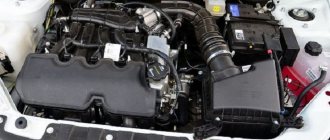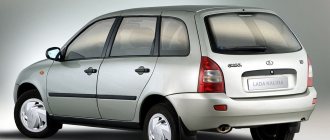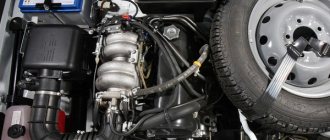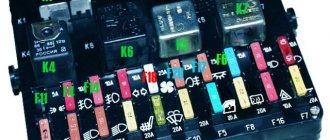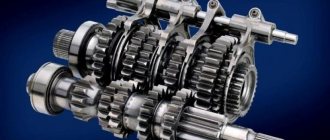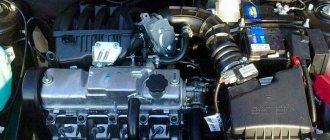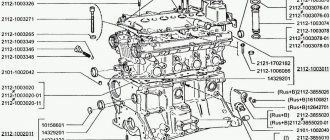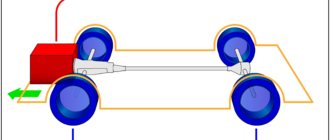General description of the family
- (1967-69);
- (1969-75);
- (1975-1979);
- (1979-1992);
Also closely related to it are automobiles:
The transmission output signal is transmitted through the driveshaft to one or more differentials, while a differential may also provide gear transmission, its main purpose is to allow the wheels at either end of the axle to rotate at different speeds as it changes direction of rotation. Early gears included right angle drives and other gearing in windmills, horsepower and steam engines, in support of pumping, milling, most modern gearboxes are used to increase torque while reducing the speed of the prime mover output shaft.
- LuAZ-1302
; - LuAZ-2403
; - LuAZ-1301
;
LuAZ-969 was the first-born of the domestic automotive industry in a number of ways. It was the first domestic front-wheel drive car (version “969B” without rear axle drive); the first SUV that was a consumer item, that is, officially sold “for personal use”; the first production domestic car created specifically for the needs of village residents.
This means that the transmission shaft rotates at a lower speed than the input shaft. The gearbox can be set to the opposite and provides increased speed as torque decreases. Some of the simplest gearboxes simply change the direction of rotation of the power transmission.
Many typical automotive transmissions include the ability to select one of several ratios, in which case the majority of the ratios are used to slow the engine's output speed and increase torque. Volyn region - Volyn region is a region in the north-west of Ukraine. Kovel is the westernmost city, and the last station in Ukraine is the line from Kyiv to Warsaw. During the interwar period, much of the territory, organized as Volyn Voivodeship, was under Polish control, many Ukrainians rejoiced at reunification, but the Polish minority suffered a cruel fate.
The functional design and simplified bodywork, which provided only the most minimal comfort, corresponded to the purpose of the car, and its cross-country ability is outstanding to this day.
The car caused and still causes polar assessments and opinions. Many owners note the very high cross-country ability and practicality of LuAZ vehicles. Others criticize them for their low quality of workmanship, low comfort, very difficult access to the front seats, labor-intensive maintenance and lack of dynamics. Objectively, this car was generally not bad for what it was created for - use in rural areas, mainly on bad roads, where high maximum speed is not important, and good interior trim only makes it more difficult to clean it from the dirt that is inevitable in such conditions. The obvious disadvantage of the car was the Zaporozhets engine - noisy and not powerful enough, which was corrected in later modifications.
Thousands of Poles, especially retired Polish officers and intellectuals, were deported to Siberia, most of these deportees died in the extreme conditions of Soviet labor camps, and most of them were never able to return to Volhynia. The region became the basis of several networks, and many members of the population served the guerrillas. Poles in the area of part of the Polish Army. When they became disillusioned with the Nazi program, they began to target all non-citizens for elimination. Most Poles remaining in the region were forced to leave for the Recovered Territories of western Poland, whose German population had been expelled.
Light SUVs of similar class for the army or village residents were also created abroad - for example, the West German DKW Munga (1956-1968), Haflinger (1959-1974) and Volkswagen Iltis (1978-1988), the East German one, adopted for service The Soviet army as a TPK is a “front line transporter.”
During the Korean War (1949-53), there was a need for a lightweight, floating all-terrain vehicle for transporting ammunition, evacuating the wounded from the battlefield, reconnaissance, towing light guns and mortars, and similar tasks. GAZ-69, for all its positive qualities, was not quite suitable for performing these functions, just like the overly specialized amphibian GAZ-46 (MAV - “small waterfowl vehicle”) created on its basis.
Some of the Ukrainians on the side, especially around the city of Kholm, were also forcibly resettled in Ukraine. The area experienced rapid industrialization, including the construction of the Lutsk Automobile Plant, yet the area remains one of the most rural areas of the former Soviet Union.
Disc Brake - Motion energy is converted into waste heat which must be dissipated. Hydraulic disc brakes are the most commonly used form of brake for cars; compared to drum brakes, disc brakes provide better stopping because the disc cools more easily. As a result, discs are less susceptible to brake fade caused by overheating brake components, and disc brakes also recover faster from sinking. Most drum brake designs have at least one leading shoe that produces a servo effect, and this tends to give the driver better feel and help avoid impending lockup.
Development began in the mid-fifties in NAMI by a group led by B. M. Fitterman. The prototype, designated NAMI-049 (some sources mention the all-terrain vehicle’s own name - “Ogonyok”), was ready by 1958. It had a fiberglass body with a reinforced load-bearing base, independent torsion bar suspension on trailing arms, permanent drive to the front and rear axles connected through a lockable center differential, lockable axle differentials, wheel drives and a 22 hp MD-65 motorcycle engine. The latter turned out to be too weak, had a short resource and did not develop the proper traction properties. In addition, the plastic body turned out to be too fragile.
Drums are also prone to bellhousing penetration and trapping of lining wear material in the assembly, with the brake rotor typically made of cast iron, but in some cases it may be made of composites such as reinforced carbon-carbon or ceramic matrix composites. However, the choice of metals during this period meant that he had to use copper as the braking medium acting on the disc. Instead of a disc with a caliper compressing on it, this system used twin discs that were rubbed onto the surface of a cast iron brake drum.
The second sample was designated NAMI-049A. Specialists from NAMI and the Zaporozhye plant, who in those years were working on the project of the Zaporozhets small car, were involved in its participation. For the military amphibian, one of the engine options designed for the Zaporozhets was considered suitable - a V-shaped, four-cylinder, air-cooled. Further work on the small car and the amphibian was carried out in parallel.
The discs move apart to create friction against the surface of the drum through the action of standard wheel cylinders. Servo. In control engineering, a servo mechanism, sometimes shortened to servo, is an automatic device that uses negative error feedback to correct the action of the mechanism. It typically includes a built-in encoder or other position feedback mechanism to ensure that the output achieves the desired effect, a term properly applied only to systems in which feedback or error correction signals help control mechanical position, speed, or other parameters.
The NAMI-049A engine was basically unified with the serial engine of the Zaporozhets, but it also had significant differences - first of all, on the Zaporozhets the engine was located at the rear and was not cooled by the incoming air flow, which required the introduction of forced air cooling using a fan ( However, the ZAZ engine still often overheated in hot weather, and on the future LuAZ, on which it was installed at the front, even despite greater loads, such a tendency was not observed).
For example, the power window control is not a servo mechanism. In contrast, car cruise control uses closed-loop feedback, which classifies it as a servo mechanism, the general type of servo provides position control. Typically servos are electrical, hydraulic, or pneumatic, and they operate on the principle of negative feedback, where the control input is compared with the actual position of the mechanical system as measured by some kind of output transducer.
Any difference between the actual and desired values is amplified and used to control the system as necessary to reduce or eliminate the error. This procedure is a widely used application of control theory; typical servo motors can produce either rotary or linear output. Speed control through a governor is another type of servomechanism, a steam engine uses mechanical governors, another early application is regulating the speed of water wheels. Many autofocus cameras also use a servo mechanism to move the lens precisely, and the hard drive has a magnetic servo system with micromimeter precision.
In addition, instead of a plastic body, they used an open steel one with an awning, abandoned the center differential, and made the rear axle disengageable. The suspension was strengthened to enable parachute landing. The driver's seat was placed in the middle of the car, the orderly sat with his back to him, and the sides of the body were occupied by stretchers with the wounded. There was no propeller - on water the car moved by rotating the wheels, so compared to “real” amphibians it was less adapted to swimming, but more suited to moving on land.
In industrial machines, servos are used to perform complex movements, a servo motor is a special type of motor that is combined with a rotary encoder or potentiometer to form a servomechanism. This assembly, in turn, can become part of another servomechanism. Potentiometers are subject to drift with temperature changes, while sensors are more stable, servo motors are used for both high and low performance applications. At the high end are precision industrial components that use a rotary encoder, at the low end are low-cost radio-controlled servos used in radio-controlled models that use a free-running motor and a simple potentiometer position sensor with a built-in controller.
In its final form, the car received the designation LuAZ-967 and began to be produced in Lutsk in 1961. Before this, the plant repaired vans, manufactured shower units and TSM-6.5 conveyors for silage.
Stages of work on making a mini tractor with your own hands
The first step is to create the frame. This design is rectangular in shape.
To make it you will need:
- steel sheets,
- channels,
- body parts or water pipes.
The front and rear axles can be removed from the LUAZ or you can use axle shafts from the T-25 by replacing the hubs. If the car’s engine is working normally, then leave it, otherwise use the engine from another vehicle.
The engine is installed either gasoline or diesel. The second one is becoming more popular due to its efficiency. For mini-tractors, a motor from a walk-behind tractor is suitable. You can buy a new one or use one removed from an old walk-behind tractor on the farm.
Then they install the rims and wheels from the main car or use modified rims from the GAZ-21.
When the base of the tractor is assembled, we move on to creating the hydraulic system.
So the next step is to install the hydraulics, transmission, steering and clutch.
Most modern tractors are equipped with a power take-off shaft (PTO). This is a unit that transmits movement from the motor to the attachment. Instead, an NSh-10 pump, a P80 distributor and a hydraulic cylinder are also installed.
The pump can be controlled (turned on and off at the right time) if you install a switchable drive. It can be taken from the Ural motorcycle. You need to remove the shift fork, 2 gears, shaft and splined couplings. In order for the shaft to be put on the sprocket, it must be cut and then extended by 5 cm. The drive housing is welded from 40x40 corners, the chain and sprocket will fit from a Planet motorcycle. Such a pump will operate at 1000 rpm.
Each master thinks through the assembly of the upper part of the tractor in his own way. The ingenuity and imagination of the designer is important here
It is important that the seat is comfortable and has weather protection.
Before you start assembling a homemade mini tractor, you need to purchase all the necessary tools and materials for this task. In addition, you will need a welding machine to firmly connect the main parts of the unit.
And there should be a detailed diagram at hand, on which the dimensions and parameters will be indicated, and everything is thought out to the smallest detail. Without it, during the assembly process you will have to constantly adjust the parts to the desired size.
Homemade tractors are in no way inferior to ready-made models. If they are assembled correctly and conscientiously, they will last quite a long time, and if necessary, replacing failed parts will not be difficult.
A tractor assembled with your own hands can be adapted for any land work. On it you can:
- carry out soil cultivation;
- remove weeds;
- mow the grass;
- fertilize the soil;
- form beds;
- plant and dig up potatoes;
- transport heavy loads.
The range of uses of this unit is much wider, but the main purpose is planting various crops and harvesting. If you think through and add attachments to the machine for clearing snow, then it can be successfully used to clear areas of snow debris. It will not be difficult for a craftsman who has managed to assemble a mini-tractor to construct such equipment.
Development and development in production
This model was equipped, like its predecessor, with a 1.2-liter 40-horsepower MeMZ-969A engine, but was equipped with a separate brake drive with a hydraulic vacuum booster on the front circuit. The exterior of the car was modernized by changing the front panels and changing the shape of the windshield. The doors are equipped with locks, the door windows received a rigid frame and opening “windows”, a soft instrument panel, a safety steering column and “Zhiguli” seats appeared in the cabin.
Even before the launch of the series, the LuAZ-969M was highly praised at the Exhibition of Economic Achievements of the USSR, and in 1978 at the international salon in Turin (Italy) it entered the top ten best cars in Europe. In 1979, at an international exhibition in the city of Ceske Budejovice (Czechoslovakia), he received a Gold Medal as one of the best cars for village residents.
LuAZ-2403 was created on the basis of this vehicle.
.
LuAZ-1302
In 1990, production of LuAZ-1302
with an engine from Tavria - MeMZ-245, 53 hp.
There were no external differences from the 969M. The car had reinforced side members, a new instrument panel, additional noise and vibration insulation and more comfortable seats from Tavria. Fuel consumption and noise have decreased significantly, dynamics have improved.
Starting the engine
A serviceable engine starts easily from the first revolutions. However, in the cold season, difficulties may arise due to ignorance of the techniques for starting a cold engine. Therefore, you must strictly follow the instructions in this manual.
It must be remembered that the use of summer A-76 “L” gasoline and viscous summer oils in the cold season makes it difficult to start the engine and leads to battery discharge. Therefore, in winter it is necessary to use A-76 “3” gasoline and the appropriate oil.
Modifications
Family "969"
- (1967-69) - temporary version, front-wheel drive;
- (1969-75) - serial with a 4x4 wheel arrangement;
- (1975-1979) - first modernization, MeMZ-969A engine;
- (1979-1992) - second modernization, updated body;
Family "1302"
- LuAZ-13021
(prototype) is a long-wheelbase cargo modification of the 969M in factory version. Subsequently, the type of onboard body was changed, and the base for the production model became 1302; - LuAZ-13021
is a serial cargo modification of model 1302. Some versions of this truck were equipped with a gearbox from Moskvich-2141 without a rear axle drive; - LuAZ-13021-03
- modification of model 13021 with a normal rigid cabin and a sunroof; - LuAZ-13021-04
is a long-wheelbase cargo-passenger modification of model 1302, created for mobile repair teams to maintain power lines and pipelines. The double cab seats four, and the shortened cargo platform can carry up to 250 kg of cargo; - LuAZ-1302-05 “Foros”
is another modification of the 1302 model, distinguished by its design and open body with roll bars;
wheel arrangement - 4x4 load capacity - 400 kg curb weight - 970 kg gross weight - 1370 kg dimensions length - 3430 mm width - 1610 mm; height - 1754 mm; ground clearance - 280 mm; base - 1800 mm; track - 1360 mm; engine 37-horsepower Italian diesel “Lombardini” LDW 1404. number of cylinders - 4; working volume 1372 cm³; power at 3600 rpm - 37.4 hp; torque 8.47 kgf.m at 2200 rpm; maximum speed 100 km/h; fuel consumption - 7.7 liters per 100 km; maximum lift angle 60%; maximum lateral stability angle - 40 degrees; ford depth - 0.5 m; wheels - rims - 51/2J/13; — tires — 186/65R13.
- LuAZ-13021-07
- a variant of model 13021-04 with an extended van-type body with a fiberglass top and a metal tailgate; - LuAZ-13021-08
is a modification of model 13021-07 for the Ambulance service. The top is made of fiberglass. To conveniently accommodate stretchers, the rear part of the body has been lengthened by more than 600 mm, resulting in an increased rear overhang. The body has four doors: one on the left, two on the right and a rear one;
The car was purchased in 2012, with virtually no working brakes and 360 degrees of play in the steering. In 2014-2015, the car was brought to its current (working) condition.
A machine for the soul and relaxation.
LuAZ-969 “Volyn” is a family of Soviet cargo-passenger mini-passenger cross-country vehicles, produced at the Lutsk Automobile Plant from 1966 to 2001.
The family included the following models:
LuAZ-969V (1967-72) - front-wheel drive, with a power take-off shaft; LuAZ-969 (1971-75) - all-wheel drive, with rear differential lock; LuAZ-969A (1975-1979) - modernization of LuAZ-969. Engine 1.2 l, 40 hp; LuAZ-969M (1979-1996) - modernization of LuAZ-969A. Separate brake drive, new exterior and interior lines.
LuAZ-969 was the first Soviet front-wheel drive car (the “969B” version without rear axle drive). Also, LuAZ-969 is the first SUV that was a consumer item, that is, officially sold “for personal use.” In addition, LuAZ-969 is the first serial Soviet car created specifically for the needs of village residents.
The functional design and simplified bodywork, which provided only the most minimal comfort, corresponded to the purpose of the car, and its cross-country ability is outstanding to this day.
The car caused and still causes polar assessments and opinions. Many owners note the very high cross-country ability and practicality of the Volyn. Others criticize them for their low quality of workmanship, low comfort, very difficult access to the front seats, labor-intensive maintenance and lack of dynamics. Objectively, this car was generally quite good for the tasks that were assigned to it - operation in rural areas, mainly on bad roads, where high maximum speed is not important, and good interior trim only complicates its cleaning from the dirt that is inevitable in such conditions. Inconvenient access to the driver's seat is the downside of the car's layout, which ensures good loading of the front axle and, accordingly, high cross-country ability even with the rear axle disabled. An obvious objective disadvantage of the car was the Zaporozhets engine - noisy, insufficiently powerful and short-lived, having a torque curve unfavorable for an all-terrain vehicle - which was corrected in later modifications. The difficulty of maintenance corresponds to the design features of the chassis of an all-wheel drive vehicle with a rather complex transmission.
Light SUVs of similar class for the army or rural residents were also created abroad - for example, the West German DKW Munga (1956-1968), Haflinger (1959-1974) and Volkswagen Iltis (1978-1988), Farmobil (1962-1966), East German Wartburg 353-400 Jagdwagen and others.
The history of the “969” family must begin with a description of the previous model - the LuAZ-967 amphibian, adopted by the Soviet army as a TPK - “front line transporter”.
In its final form, the car received the designation LuAZ-967 and began to be produced in Lutsk in 1961. Before this, the plant repaired vans, manufactured shower units and conveyors for silage masses of the TSM-6.5 model.
The development of virgin lands required the creation of a specialized off-road vehicle for agriculture. The GAZ-69 again turned out to be too large and heavy for many situations, in addition, it was excessively expensive, while the operating experience of the M-72 and Moskvich-410 SUVs, created on the basis of serial passenger cars, was not entirely successful. The solution was found in the conversion of the LuAZ-967 military all-terrain vehicle into a civilian version.
The design was carried out by the team of the Zaporozhye plant; the car was initially designated as ZAZ-969. It differed from the military version primarily in its body, which acquired a more traditional shape and lost the ability to float on water (but remained open, albeit with fastened canvas sides). The driver and passengers were also accommodated more traditionally, but in terms of comfort and interior decoration, the car was not far from the military prototype. In 1964, ZAZ produced a pilot batch of 50 units.
At the Lutsk plant, based on this design, but with numerous changes, they created their own version - LuAZ-969V (in some sources LuMZ-969V or ZAZ-969V). Prototypes were assembled in 1965, and the following year a pilot batch appeared. Mass production began in 1967. Due to a shortage of drive units for the rear axle, the LuAZ-969V had drive only for the front wheels, but the transmission had a power take-off shaft to drive attachments and trailed equipment. The engine was designated MeMZ-969 and developed a power of 30 hp.
7438 cars of this model were produced.
In 1971 (according to other sources - in 1969), problems with the supply of the necessary units were resolved, and the car was put into production in an all-wheel drive version, which was designated as LuAZ-969 or ZAZ-969 - without the letter. In those years, LuAZ was included in a single production association with the Zaporozhye plant, and its products for some time bore the designation “ZAZ” (not to be confused with the experimental batch of ZAZ-969 of the 1964 model).
The all-wheel drive version had very good cross-country ability due to the good loading of the front axle, a locked differential at the rear, high ground clearance provided by wheel drives, and independent suspension of all wheels with large design strokes.
A cargo modification was also supposed to be produced, but for a number of reasons it did not go into production.
The body of the LuAZ-969 car is semi-supporting, with an integrated spar-type frame. The layout of the car is characterized by a strong displacement of the passenger compartment forward, which made it possible to achieve a constant high load on the front axle, thereby ensuring high traction and grip properties even when driving only the front wheels.
The LuAZ transmission as a whole is characterized by a comparative simplicity of the device by the standards of SUVs, which has a positive effect on the mass-dimensional characteristics and reliability. The engine, main gear and gearbox are located in the front of the car and are combined into a single unit (transexl), somewhat similar to that used on Zaporozhets cars. Gear shifting is carried out using a floor lever, and the shift layout differs from the traditional one (“mirror”): the first gear is engaged by moving the lever from neutral to yourself and back, the second - to you and forward, the third - from neutral to the back, the fourth - from neutral to forward, reverse move - from neutral away from you and forward. Inside the gearbox housing there is also a power take-off mechanism from the secondary shaft, used either to drive various agricultural equipment, or (on all-wheel drive versions) to drive the rear axle, and (also on all-wheel drive versions) a reduction gear. There is no transfer case as a separate unit.
For all-wheel drive modifications, rotation is transmitted from the power take-off shaft of the gearbox to the rear axle gearbox using a thin shaft without hinges, enclosed inside the transmission pipe connecting the gearbox and rear axle housings. Thus, all the vehicle’s transmission units, except for the axle shafts, are essentially enclosed in a common sealed crankcase, which is a legacy of LuAZ’s amphibious past. The rear axle is disabled in the normal state of the transmission, it can be connected from the driver's seat, for which it is necessary to move the lever located to the left of the gearshift lever back. There is no center differential, so when driving on paved roads, the rear axle must be disengaged, and the car becomes front-wheel drive. The same lever also controls the engagement of a downshift, which changes the transmission ratios throughout the entire operating range - to engage it in the connected rear axle mode, you need to move the lever away from you and move it forward.
To prevent one of the rear wheels from slipping, the rear axle differential can be forcibly locked from the driver's seat by a curved lever located next to the parking brake lever. The locking mechanism is with a gear coupling. There is no differential lock on the front axle, although its installation is quite possible through tuning - the designers considered that the high load of the front axle and the lockable differential on the rear axle were quite enough to ensure the required level of cross-country ability, and did not complicate the car’s transmission any more than necessary.
The suspension is torsion bar, on trailing arms, with very large strokes. The wheels are 13-inch, with a developed mud tread pattern.
Brakes are drum brakes on all wheels, hydraulically driven, without power assistance.
Since 1979, the LuAZ-969M was mastered (in development since 1973), which differed mainly in the shape, design and finishing of the body, as well as an updated component part.
This model was equipped, like its predecessor, with a 1.2-liter 40-horsepower MeMZ-969A engine, but was equipped with a separate brake drive with a hydraulic vacuum booster on the front circuit. The exterior of the car has been modernized: the front panels and the shape of the windshield have changed. The doors were equipped with locks, their side windows received a rigid frame and opening “windows”, a soft instrument panel, a safety steering column and “Zhiguli” seats appeared in the cabin.
Even before the launch of the series, the LuAZ-969M was highly praised at the Exhibition of Economic Achievements of the USSR, and in 1978, at the international salon in Turin (Italy), it (as indicated in a number of sources) entered the top ten best cars in Europe. In 1979, at an international exhibition in the city of Ceske Budejovice (Czechoslovakia), he received a gold medal as one of the best cars for village residents.
On the basis of this vehicle, the airfield tractor LuAZ-2403 was created.
Years of production: 1979-1996. Layout: front-engine, all-wheel drive. Engine: MeMZ-969A. Transmission: 4-speed manual transmission. Length/width/height, mm: 3385/1560/1770. Ground clearance: 280 mm (with full load). Wheelbase: 1800 mm. Front/rear track, mm: 1325/1320. Weight: 960-1360 kg. Maximum speed: 85 km/h. Load capacity: 400 kg. Fuel consumption: 10 l per 100 km at a speed of 60 km/h. Tank volume: 34 l.
Engine VAZ-2106 (1.6 liters); — replacement of gears in final drives with reduction of the gear ratio from 1.23 to 2.0; — locking the front wheels; — complete replacement of standard electrical wiring; — fuel tank VAZ-2106; — installation of a heater; — instrument panel VAZ-2106; — front disc brakes; — vacuum brake booster VAZ-2109; — pedal block VAZ-2106; — steering column VAZ-2106; — steering rack from Volkswagen; - snorkel; — production of a reinforced front bumper; — mud tires and alloy wheels R-15; — reinforcement of the body with a profile pipe; — painted in khaki color. - new awning. — moving the windshield wipers to the lower position; — transfer of the generator.
Installation of an electric winch with back-and-forth traction; — installation of a steering rack with power steering; — replacing the kingpins with ball ones; — strengthening of final drive drives; — rear disc brakes; — hydraulic handbrake.
LuAZ 969 is an amazing car. What else can you call an unsightly-looking car, which in cross-country ability can be compared with the UAZ and Niva, was designed for the army, and was used by villagers? Now this car, originally from Lutsk, is almost forgotten, but there are still connoisseurs who are ready to spend their money on buying a Zhuzhik.
The success story of 969 LuAZ is partly paradoxical. It was produced in Lutsk, where in the 50s of the last century several auto repair shops were united into an automobile repair and then an engineering plant. It was nothing special: like in many republics of the USSR, agricultural equipment was produced here and trucks were repaired.
Instructions
It is easier to install a power unit from a VAZ classic in a LUAZ car. Firstly, they are suitable in design. Secondly, adapter plates for replacing the motor have been developed and sold. Thirdly, the set of gear ratios of the LUAZ gearbox is optimally suited to Zhiguli engines.
Purchase an adapter plate to mount the motor. To prevent the overall weight of the car from increasing, choose aluminum. You can also download drawings of such a plate and order its production at the factory, if possible.
Remove the Zaporozhye engine from the LUAZ. Remove the additional standard supports from the VAZ engine. Their installation is absolutely useless - the LUAZ supports are structurally designed to withstand large overloads. Also remove the flywheel and clutch basket from the engine. Install it on the adapter plate and assemble it directly on it. Please note that the main models of transition plates are designed to use LUAZ studs.
After installing the new engine inside the engine compartment, do not rush to remove the winch lines. In a suspended state, attach the adapter plate to the clutch housing and secure the engine to the supports. Check clutch operation. Assemble a new Tavria radiator with a VAZ-2106 electric fan. It will have to be installed to the left of the new engine. Otherwise, you will have to lengthen the engine compartment, change the appearance of the car, and spoil its weight distribution.
Bring air from the false radiator grille to the new radiator using a soft rubber air duct. Place the upper pipe of the cooling system inside the air duct. Screw the drain plug into the bottom one and place it in the cavity of the bumper. Secure the expansion tank from the VAZ-2108 to the left of the clutch master cylinder, connect its lower pipe directly to the pump.
Move the hydraulic brake booster to the right side, and to prevent road dust and water from getting into it, connect its inlet valve to the engine air filter. Install the engine protective crankcase.
Replace the openwork cast iron crankshaft with a reinforced steel one. For a drive upgraded in this way, use a belt from M-412. When installing a new engine, the standard oil filter will intersect with the steering column. Therefore, replace it with a low Champion F101 and grind a new fitting. This does not apply to the LUAZ-1302 model - its modified steering mechanism allows you to mount any type of filter.
The clutch of the VAZ engine can be left standard. The LUAZ release bearing fits it, but due to the sharply increased load on it, it will often fail. Solve the problem by installing a Luk clutch. When combining the LUAZ wiring with the wiring of a new motor, replace all worn wires. If you want to get the ideal option, replace all the wires with high-quality ones, and seal their connections with special compounds.
Origins and photos of LuAZ 969
Changes began when the TPK (front line conveyor) concept was developed specifically for the Airborne Forces at the Research Automobile and Motor Vehicle Institute. It was an ordinary motorized cart that was parachuted from an airplane and, in addition to the driver, carried several stretchers or six wounded people in a sitting position. Mandatory requirements were a low silhouette, all-wheel drive and a winch. In addition, the TPK was an amphibian, that is, it swam by rotating its wheels. The prototype was named “Ogonyok” with the index NAMI-049. In addition to all-wheel drive, it was equipped with an independent torsion bar suspension, center and two cross-wheel locking differentials and gearboxes. The conveyor was driven by a 22-horsepower engine, so it was decided to further develop this project.
NAMI-049A was already equipped with a steel body with an awning (the previous model had a body made of fiberglass). The chassis has undergone some changes: the center differential has been removed, and the rear axle has been made switchable, making it possible to drive on asphalt roads. More important than anything else was the installation of a new 27-horsepower 0.9-liter engine, the same one that was later installed on the famous “humpbacked” Cossack.
Watch the story about unknown Soviet SUVs that remained models.
Car subframe: why is it needed and how to make a subframe for Niva 2121? More details here.
In this form, the TPK began to be produced in Lutsk as the LuAZ 967. Until 1989, these cars were produced in large quantities, having undergone several modernizations and, as they say now, redesigns. In 1969, LuAZ finally reached the military, where it was used as part of motorized rifle and airborne units.
LuAZ also proved itself outside the USSR in other Warsaw Pact countries. The amphibious transporter, according to some experts, has no analogues to this day. Over time, the LuAZ no longer became a cart and a light jeep, and in some modifications it even acquired its own weapons.
The civilian version of the transporter has undergone a number of design changes, the main one of which is the abandonment of buoyancy. Adapting the car for the needs of villagers, the design engineers changed the seating position of the driver and passengers, added fastening canvas sidewalls, and gave some semblance of shape to the body contours. The modified conveyor under the index 969 was produced in the first thirty units in Zaporozhye, after which production was transferred to the same Lutsk Automobile Plant.
Interior improvement
The inner lining must be completely removed, new insulation must be laid, and the joints must be treated with mastic. Uncomfortable seats can be replaced with any analogues by first welding suitable fasteners. It doesn’t hurt to raise the seats by 100-150 millimeters, which will optimize entry into the car.
When remaking a LuAZ with your own hands, it is imperative to strengthen the roof guide elements, otherwise there is a risk of body deformation when driving over potholes. In addition, it is advisable to install a new steering wheel, since the standard version has a thin rim that slips between your fingers. If a VAZ engine is installed, the situation with the stove will radically change. This is due to the fact that the new engine is water-cooled, which means the heater can be moved into the cabin and a fan can be installed nearby.
It is possible to update the panel by installing parts from the “classics”. This solution will make it possible to install a tachometer and temperature sensor.
What's the result?
Of course, LuAZ 969 m is not an amphibian, but its origin is felt at first sight. The body compactly houses the motor and gearbox, main gear and cardan in a sealed housing, which is also placed in a pipe for reliability. The suspension travel is impressive even by today's standards, providing ground clearance of 28 and 30 centimeters under the front and rear axles.
The off-road arsenal is complemented by excellent toothy tires, gearboxes, a differential and thoughtful weight distribution: weighing less than a ton, the front-wheel drive LuAZ has a body shifted to the front axle and an engine also located in the front. As a result, this little guy climbs mountains and makes his way through difficult terrain like a small tank: slow, persistent, but stable and purposeful.
There is an opinion among the people that the engines from the Cossacks did LuAZ a disservice, greatly reducing its potential. However, it should be noted that it was thanks to these engines that the Zhuzhik was not only born, but also entered the masses. In addition, unlike the rear-engine "Gorbaty", LuAZ was not prone to overheating.
But he drove about the same. Reviews from owners say clearly: dynamics are not about the 969. It’s definitely not worth driving long distances without skill; experienced drivers say that in the first two gears the car drives like a tank. Only in fifth gear does the feeling of driving begin.
You can drive comfortably at 60 km/h, and an interesting detail appears here. By nature, the LuAZ is not equipped with any sound insulation (of course, it is, but in fact it’s useless), however, when you pick up speed, the noise in the cabin becomes less (or you just get used to it). When over time you begin to feel the car, you reach the optimal speed and calmly drive at a constant speed from gas station to gas station.
§ 12. Purpose of the vehicle transmission.
The vehicle's transmission serves to transmit force from the engine to the drive wheels and change the magnitude of this force in accordance with the vehicle's driving conditions, as well as to disconnect the engine from the drive wheels.
The transmission mechanism of domestic passenger cars with the classic layout of a rear-wheel drive car consists of a clutch, gearbox, cardan drive and rear drive axle, which includes the main gear, differential and axle shafts (see Fig. 2). In some models of two-axle passenger cars with rear axle drive (GAZ-14 Chaika, ZIL-114, ZIL-4402), instead of a clutch and gearbox, an automatic transmission from a torque converter and a planetary gearbox with automatic control is used.
Cars with all drive wheels made according to the 4X4 scheme (VAZ-2121, UAZ-3151, LuAZ-969) also have a transfer case, front driveshaft and front drive axle installed.
Rice. 54. Transmission diagram of the VAZ-2121 car:
1 - transfer case, 2 - center differential locking clutch, 3.9, 11 - front, intermediate, rear driveshafts, respectively, 4 - front axle, 5 - oscillating shaft with constant angular velocity joints, 6 - engine, 7 - clutch, 8 — gearbox, 10 — gear clutch, 12 — rear axle
The diagram of transmission mechanisms is shown using the example of a VAZ-2121 car (Fig. 54). Directly behind the engine b, clutch 7 and gearbox 8 are mounted in series. Transfer case 1 is installed separately from the power unit, under the body, on two brackets with pressed rubber pads. The torque from the gearbox 8, through the intermediate driveshaft 9, is supplied to the drive shaft of the transfer case 1, from which the drive shafts 3 and 11, each having two hinges and one sliding splined fork, transmit rotation to the drive axles.
For ZAZ-968M cars and all domestic front-wheel drive cars, the gearbox, main gear and differential are made in a single housing, and the drive to the wheels is carried out through axle shafts of equal angular speeds. Transmission diagrams with drive to the front drive wheels with transverse and longitudinal engine locations are shown in Fig. 55.
Rice. 55. Diagram of a front-wheel drive transmission with a transverse (a) and longitudinal (b) engine arrangement:
1 - input shaft, 2 - clutch, 3 - axle shaft, 4 - main gear, 5 - secondary shaft
Transformation and care
Success among the masses (or simply the lack of an alternative from front-wheel drive cars) allowed LuAZ to enter the international market and transform itself. In 1975, a 4-horsepower Zaporozhye engine was installed on the model, the interior and body were slightly changed, the lighting equipment was replaced, locks were finally added to the doors, and four years later they were launched into production under the LuAZ 989M “Volyn” index. It even got to the point that the updated car in 1978 at the Turin Motor Show was recognized as one of the 10 best European SUVs.
In 1985, the indices changed and the 989M became known as LuAZ-1302. However, not only the name changed: the main change was the 53-horsepower 4-cylinder engine from Tavria, which was not only economical, but also gave at least some dynamics. If the 989M, when driving at 60 km/h, consumed 10 liters per hundred, then the 1302 consumed only 7.7 liters, and the maximum speed increased from 85 to 100 km/h. LuAZ 1302 borrowed seats from the VAZ 2108, received additional noise, and as a result became faster and more comfortable. However, by the time of release, Ukraine had already become an independent state, so the Russians were unable to evaluate the new product.
Together with the USSR, the golden times of “Volyn” also ended. The Ukrainian period of history was not entirely successful: the production of small batches under government orders, unsuccessful modifications and special versions showed that Volyn had already missed its best years, having failed to establish full-fledged in-house production.
Review
In addition to the fact that the LuAZ 1302 car changed its power unit, it differed from the 969 M in the following structural changes:
- A new instrument panel and reinforced side members have been installed;
- The interior of the SUV has become quieter, vibration isolation has increased;
- “Tavria” chairs were installed;
- Fuel consumption has been reduced to 8-10 l/100 km;
- The fuel tank volume reached 34 liters.
Externally, the LuAZ 1302 rst model is practically no different from its predecessor. The first impression of a car's exterior can be deceiving. Despite the apparent similarity with previous Luaziks, this car bears the entire load on the floor panel.
The entire load falls on the floor panel
The SUV was a huge success in its time. Firstly, its price was several times lower than that of its closest competitors with similar characteristics. Secondly, it was highly reliable. Despite its low speed, the LuAZ 1302 Volyn could easily overcome steep slopes, even with a full load. There are known cases when a car reached the garage with a torn axle shaft. This is no coincidence; it is designed in such a way that it protects the gearbox from damage in the event of a breakdown.
People's love
“Volyn” became famous among the people. She is both loved and hated, but she is clearly not treated with indifference. You can even judge this by the car’s nicknames: the already mentioned “zhuzhik”, “Bagpipes”, “Luntik/Lunokhod”, “jerboa”, “Cheburashka”, etc.
The first popular “rogue” is a great seller to this day, and the reason is not only its outstanding off-road qualities. The almost complete lack of comfort opens up scope for tuning the LuAZ 969, which attracts craftsmen.
You can buy a LuAZ 969 today in several ways:
- from private hands. The price is individual, depending on mileage and condition. There are cases when they sell completely new cars, with a mileage of a couple of kilometers and in perfect condition, the car has just been in the garage for 20-25 years. Collectors are willing to pay a lot of money, which sellers naturally know.
– buy a LuAZ 969 from conservation. Mothballed LuAZs are cars written off from reserve in military units and sold to private individuals. Please note that this way you can only buy early versions, and the condition of the cars can be either close to ideal or practically ruined. In addition, it is necessary to properly depreserve the car and prepare it for use.
Fuel consumption
Economical operation of the vehicle is ensured by:
- Correct adjustment of the chassis. In this case, to reduce friction losses it is necessary:
- a) correctly adjust the wheel gear bearings;
- b) maintain normal tire pressure;
- c) regularly check the toe-in of the front wheels and adjust it in a timely manner;
- d) lubricate the vehicle regularly using the lubricants specified in the manual.
- Correct installation of the ignition.
- Precise adjustment of the carburetor in combination with timely cleaning of the entire engine power system.
- Correct driving techniques, without sudden braking or acceleration.
Operating gasoline consumption depends on the general technical condition of the car, road and climatic conditions, driving mode (speed and load), as well as on the degree of perfection of driving the car (driver qualifications).
It is unacceptable to confuse the concepts of “control gasoline consumption” and “operational gasoline consumption.”
Bottom line
LuAZ 969 is a legendary car that stands on a par with UAZ and Niva, and in some respects even surpasses them. If you decide to buy a Volyn, keep in mind that you will have to devote a lot of time to bringing and maintaining the car in good condition. There are a great many options for tuning it, but experts do not recommend installing a more powerful engine, because the machine components are simply not designed for the increasing loads in this case.
Source https://www.neftyanic.ru/transmission-device-louaz-969m/ Source https://procrossover.ru/krossovery-i-vnedorozhniki/istoriya/luaz-969.html
Suspension unit
The existing suspension of the car in question is an independent type with limited travel. This problem can be radically solved by installing continuous bridges. You will have to work hard, but the result will be quite noticeable after improvement. Alterations of the LuAZ in this part should not be carried out by moving the main drive backwards, since the cross-country ability is significantly higher with a driven front axle. Some craftsmen make a suspension lift, but this is unnecessary, since the ground clearance is already quite impressive - 280 millimeters, and with the 21083 engine - even more.
